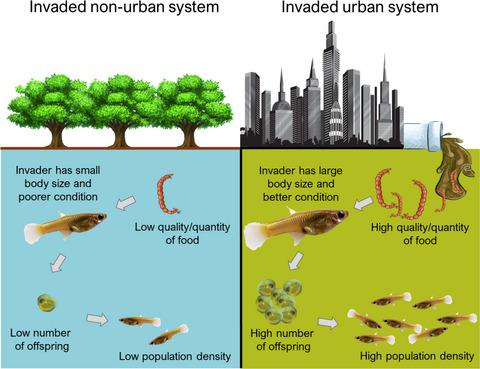当前位置:
X-MOL 学术
›
J. Anim. Ecol.
›
论文详情
Our official English website, www.x-mol.net, welcomes your
feedback! (Note: you will need to create a separate account there.)
Urbanization can increase the invasive potential of alien species
Journal of Animal Ecology ( IF 3.5 ) Pub Date : 2020-07-28 , DOI: 10.1111/1365-2656.13293 Piatã Santana Marques 1 , Luisa Resende Manna 2 , Therese Clara Frauendorf 1 , Eugenia Zandonà 2 , Rosana Mazzoni 2 , Rana El-Sabaawi 1
Journal of Animal Ecology ( IF 3.5 ) Pub Date : 2020-07-28 , DOI: 10.1111/1365-2656.13293 Piatã Santana Marques 1 , Luisa Resende Manna 2 , Therese Clara Frauendorf 1 , Eugenia Zandonà 2 , Rosana Mazzoni 2 , Rana El-Sabaawi 1
Affiliation

|
Abstract Alien species often flourish and become invasive in urban ecosystems. How and why invaders succeed in urban systems is an important, yet poorly understood, question. We investigate whether the success of urban invaders is related to changes in species traits that enhance invasive potential. We also explore whether a trophic mechanism helps explain the success of invaders in urban systems. We use the guppy Poecilia reticulata, a globally distributed alien species that has invaded both urban and non‐urban systems, as our model. We first characterize the effect of urbanization on streams where guppies are present. We measure guppy invasion success using their population density and size‐frequency. Then we assess how traits that are related to the potential of guppies to invade (life history and condition) respond to urbanization. Next, we explore how urbanization affects the availability of food for guppies and their diets. We also test if the presence of other fish species grants biological resistance to invasion by dampening guppy invasive potential. We find that urban streams have high concentrations of ammonium and faecal coliforms, indicating contamination from sewage. On average, guppy populations from urban streams have 26× higher density and larger body sizes than non‐urban populations. Urban guppies are in better condition and have on average five more offspring than non‐urban guppies. Urbanization increases the availability and consumption of highly nutritious food (chironomid larvae) by guppies. We find a positive relationship between the consumption of chironomids and both fecundity and condition. The presence of other fish species in urban streams often has a negative but small effect on guppy traits and density. Our data suggest a relaxation of trade‐offs that shape life‐history traits which is related to increased food resources in urban streams. These indicate that urbanization enhances the invasive potential of guppies through a trophic mechanism that simultaneously increases reproduction and somatic investment. Such mechanism is likely widespread because chironomids are often highly abundant in urban systems. Thus, not only guppies but also other invasive species can take advantage of such a resource to invest in traits that enhance invasion success.
中文翻译:

城市化可以增加外来物种的入侵潜力
摘要 外来物种经常在城市生态系统中繁衍生息并成为入侵者。入侵者如何以及为何在城市系统中取得成功是一个重要但知之甚少的问题。我们调查了城市入侵者的成功是否与增强入侵潜力的物种特征的变化有关。我们还探讨了营养机制是否有助于解释入侵者在城市系统中的成功。我们使用孔雀鱼 Poecilia reticulata 作为我们的模型,它是一种全球分布的外来物种,已经入侵了城市和非城市系统。我们首先描述城市化对存在孔雀鱼的溪流的影响。我们使用种群密度和大小频率来衡量孔雀鱼入侵的成功率。然后我们评估与孔雀鱼入侵的潜力(生活史和状况)相关的特征如何响应城市化。下一个,我们探索城市化如何影响孔雀鱼及其饮食的食物供应。我们还测试了其他鱼类的存在是否会通过抑制孔雀鱼的入侵潜力来增强生物对入侵的抵抗力。我们发现城市河流有高浓度的铵和粪便大肠菌群,表明受到了污水的污染。平均而言,来自城市溪流的孔雀鱼种群的密度和体型比非城市种群高 26 倍。城市孔雀鱼状况更好,平均比非城市孔雀鱼多 5 个后代。城市化增加了孔雀鱼对高营养食物(摇蚊幼虫)的供应和消费。我们发现摇蚊的消耗与繁殖力和状况之间存在正相关关系。城市溪流中其他鱼类的存在通常会对孔雀鱼的性状和密度产生负面影响,但影响很小。我们的数据表明,可以放宽与城市河流中食物资源增加有关的生活史特征的权衡取舍。这些表明城市化通过同时增加繁殖和躯体投资的营养机制增强了孔雀鱼的入侵潜力。这种机制可能很普遍,因为摇蚊在城市系统中通常非常丰富。因此,不仅孔雀鱼而且其他入侵物种都可以利用这种资源来投资提高入侵成功率的性状。这些表明城市化通过同时增加繁殖和躯体投资的营养机制增强了孔雀鱼的入侵潜力。这种机制可能很普遍,因为摇蚊在城市系统中通常非常丰富。因此,不仅孔雀鱼而且其他入侵物种都可以利用这种资源来投资提高入侵成功率的性状。这些表明城市化通过同时增加繁殖和躯体投资的营养机制增强了孔雀鱼的入侵潜力。这种机制可能很普遍,因为摇蚊在城市系统中通常非常丰富。因此,不仅孔雀鱼而且其他入侵物种都可以利用这种资源来投资提高入侵成功率的性状。
更新日期:2020-07-28
中文翻译:

城市化可以增加外来物种的入侵潜力
摘要 外来物种经常在城市生态系统中繁衍生息并成为入侵者。入侵者如何以及为何在城市系统中取得成功是一个重要但知之甚少的问题。我们调查了城市入侵者的成功是否与增强入侵潜力的物种特征的变化有关。我们还探讨了营养机制是否有助于解释入侵者在城市系统中的成功。我们使用孔雀鱼 Poecilia reticulata 作为我们的模型,它是一种全球分布的外来物种,已经入侵了城市和非城市系统。我们首先描述城市化对存在孔雀鱼的溪流的影响。我们使用种群密度和大小频率来衡量孔雀鱼入侵的成功率。然后我们评估与孔雀鱼入侵的潜力(生活史和状况)相关的特征如何响应城市化。下一个,我们探索城市化如何影响孔雀鱼及其饮食的食物供应。我们还测试了其他鱼类的存在是否会通过抑制孔雀鱼的入侵潜力来增强生物对入侵的抵抗力。我们发现城市河流有高浓度的铵和粪便大肠菌群,表明受到了污水的污染。平均而言,来自城市溪流的孔雀鱼种群的密度和体型比非城市种群高 26 倍。城市孔雀鱼状况更好,平均比非城市孔雀鱼多 5 个后代。城市化增加了孔雀鱼对高营养食物(摇蚊幼虫)的供应和消费。我们发现摇蚊的消耗与繁殖力和状况之间存在正相关关系。城市溪流中其他鱼类的存在通常会对孔雀鱼的性状和密度产生负面影响,但影响很小。我们的数据表明,可以放宽与城市河流中食物资源增加有关的生活史特征的权衡取舍。这些表明城市化通过同时增加繁殖和躯体投资的营养机制增强了孔雀鱼的入侵潜力。这种机制可能很普遍,因为摇蚊在城市系统中通常非常丰富。因此,不仅孔雀鱼而且其他入侵物种都可以利用这种资源来投资提高入侵成功率的性状。这些表明城市化通过同时增加繁殖和躯体投资的营养机制增强了孔雀鱼的入侵潜力。这种机制可能很普遍,因为摇蚊在城市系统中通常非常丰富。因此,不仅孔雀鱼而且其他入侵物种都可以利用这种资源来投资提高入侵成功率的性状。这些表明城市化通过同时增加繁殖和躯体投资的营养机制增强了孔雀鱼的入侵潜力。这种机制可能很普遍,因为摇蚊在城市系统中通常非常丰富。因此,不仅孔雀鱼而且其他入侵物种都可以利用这种资源来投资提高入侵成功率的性状。









































 京公网安备 11010802027423号
京公网安备 11010802027423号